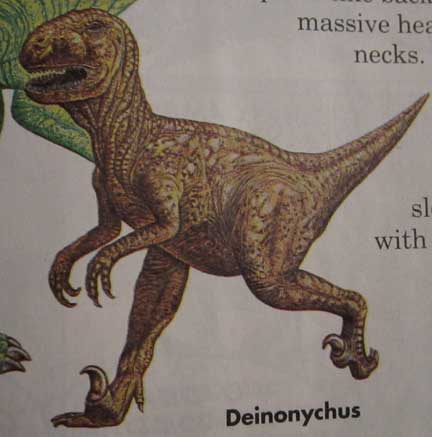Planet Dinosaur drew to a close tonight with an episode entitled 'DINOGEDDON'. Well no, not really - it was 'The Great Survivors'. Nevertheless, the series ended, inevitably, with the extinction of the nonavian dinosaurs, but we were allowed a little therizinosaur and terrifying pterosaur fun along the way.

Above: "What the hell just happened?" © BBCThe episode began with a look at the dwarf dinosaurs of Hațeg Island, including the titanosaur
Magyarosaurus and some unnamed deinonychosaur, but sadly not
Balaur (now THAT would've been a cool animal to feature). While the terrifyingly authoritative voice of John Hurt explained island dwarfism, the main stars of this segment were not dinosaurs, but pterosaurs - specifically, the honkin' great
Hatzegopteryx, which is the disputed holder of the title of 'biggest pterosaur'. The show might not have been absolutely accurate in its depiction of the animal (not that I would know - there have been mutterings from the experts), but it did a wonderful job making them look like something from your worst nightmare.
I mean, can you imagine? "Hey kids, look at that magnificent soaring beast! I think it's coming in to land...HOLY SHIT RUN FOR YOUR LIFE!" Once again, the giant pterosaurs were depicted picking off juvenile titanosaurs, this time in increasingly grizzly fashions that even topped the previous episode. Low camera angles helped emphasise the intimidating height of the pterosaurs as their creepy, triangular heads came snapping in, gulping down little sauropods whole. To make them extra disturbing, the animators gave their necks marionette-style, herky-jerky movements as they stalked forward. Put these in the next
Jurassic Park movie, please - they'd be exactly one hundred times scarier than ridiculous cartoon
Pteranodon with teeth.
Returning to the world of, you know, dinosaurs, the episode had a look at the therizinosaurs and
Nothronychus in particular. In keeping with the theme of dinosaurs' often extraordinary evolutionary adaptations, much was made of how the therizinosaurs represented an offshoot of a quintessentially carnivorous dinosaur clade turned herbivorous. The therizinosaurs looked good for the most part (fear not - there was protofuzz), as did their primitive tyrannosaur antagonists. There was even time for an enjoyable sojurn into the merry world of mass death by botulism, as once more commendably supported by fossil evidence.
Just as
Carcharodontosaurus was recycled in the previous episode, so
Gigantoraptor made a comeback here, flapping its arms about and looking ridiculous while battling
Alectrosaurus (which was actually one of the better of the usually poorly animated dino-on-dino scraps). The main point of this section was to present the extraordinary brooding oviraptorosaur fossils, and every good dinosaur nerd will have recognised the
Citipati specimen 'Big Mama' in the lineup. The programme introduced a little schmaltz (if you'll pardon the Americanism) with a pair of beak-nuzzling lovey-dovey
Gigantoraptor, but made up for it by duly burying the male alive under an enormous collapsing sand dune. The repeated use of the term 'oviraptorid' and the incorrect feather placement did niggle, but it was entertaining overall, and did introduce the audience to some of the most amazing fossils to come out of Mongolia.
Finally, then, we came to DINOGEDDON. Sixty-five million years ago, blah blah, asteroid, dust cloud, starvation. The end of the Cretaceous as depicted in
Planet Dinosaur didn't quite have the same gravitas as in
Walking With Dinosaurs (although maybe I'm a sucker for baby
T. rex puppets), and if anything just felt a bit...unnecessary. Unlike
Walking With Dinosaurs, the show was not at all in chronological order and did not need wrapping up in the same way - and did we really need to be told all about how the nonavian dinosaurs were wiped out by an asteroid yet again? Some of the graphics shown were helpful - especially when it came to demonstrating how clades besides the Dinosauria were hugely impacted by the extinction event - but there was an odd separation of 'dinosaurs' and 'birds'. Dinosaurs - 100% gone. Birds - 95% gone. Hey, wait a minute...
Ultimately, what bothered me about the end of the show was that it was not made clear that the pterosaurs and plesiosaurs shown during a montage of footage while John Hurt spoke of the evolutionary success of the 'dinosaurs'
weren't dinosaurs. Granted, the show never referred to them as 'dinosaurs', but this sequence certainly implied that they were, and the last thing anyone needs is for that confusion to be perpetuated - never mind the idea that birds are so special that they transcend being dinosaurs. I like birds, I really do, but look at them - they're dinosaurs, one and all.
At the very end of the show, Hurt spoke of the 'end of Planet Dinosaur'. Of course, the truth is it didn't end. Today dinosaurs are represented by over 9,000 species of birds, outnumbering mammal species two to one.
Walking With Dinosaurs, to its credit, pointed this out, so it's a shame that
Planet Dinosaur, given its excellent adherence to scientific evidence, didn't do the same.
Still, that won't impact too greatly on what was otherwise an excellent series. The animation could be ropey at times, but the makers of this series tried really hard - moreso than anyone before them - to present a show that was both educational and a spectacle. It was a real breath of fresh air to
see the fossils, and an absolute joy to think that many people were being introduced to them all for the first time. Bravo
Planet Dinosaur.



























